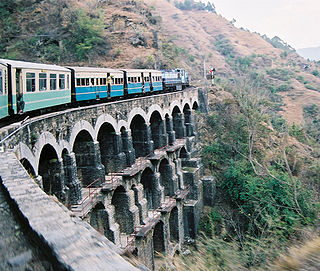It’s a victory of languor over haste, style over speed, fun over convenience. It’s a testament to the idea that the journey is as important as the destination. According to the railway authorities, there are more people using the line today than in its heyday during the Raj. And it still doesn’t go any faster than 25 km per hour. A bus will get you from Kalka to Shimla in 31/2 hrs — 2 hrs less than the train. Yet in holiday season the trains are jam packed, and advance bookings are essential.
The first passenger train began to run on 9th November, 1903. The line begins at 2,100 ft at Kalka and climbs to 6,811 ft at Shimla, traversing 96.6 km of delicious scenery. There are 18 stations en route and 102 tunnels in use. In 2008, UNESCO recognised the Kalka-Shimla line as a World Heritage Site and described it as ‘one of the most authentic mountain railways in the world’.

Kalka-Shimla toy train (Photo courtesy of A.M.Hurrell)
Tunnels, Bridges and more
This IRCTC train begins in Kalka at a slow meandering gait, and never ever picks up (maximum speeds attained are 25-30 km per hour). Nor do you want it to. The corkscrew ascent starts almost immediately, rising above the factoryinfested suburbs of Parwanoo, into the forested hills. On one side, there are showers of bamboo alternating with stout, age-blackened stone embankments, while on the other, the valley drops further and further below. Dharampur is the first big halt and you’re already 4,900 ft above sea level. The train climbs higher, as tunnels and bridges and tracks heave in and out of view as you skirt the mountain.
The tunnels and bridges are numbered. En route are villages that cling to hillsides, and fields that have flattened slopes. Mostly, the train whistles its way past a symphony of pine, deodar and oak. Children play under banyan trees and wave goodbyes. Start early and remember to carry food and water. Every tunnel is justifiably a cause of much excitement. They are all round-mouthed, stone-lined constructions with whitewashed borders. Large mirrors were used during their construction for lighting and remained in use for maintenance for years. Most tunnels are small; many are mere doorways. The Dagshai- Barog tunnel is the longest (1,143.61m) and the most famous.
Barog station
The incredibly charming Barog Station, awaits you with samosas, cutlets and tea if you’re on the Shivalik Express. Freshly painted wooden offices, a café and wood-and-glass retiring rooms. Towering above the tunnel and the station is a wall of a hill; there is a narrow valley in one direction from which flows a small stream and gurgles its way under the train track past the toy-like station. Oak and pine trees cling to the slopes. A road is now being made, after Barog has celebrated its 100th birthday, to connect the station to the highway. The Himachali-sounding ‘Barog’, with its hard middle syllable, is actually an English name. Mr Barog was the original British railway engineer in charge of building a tunnel here. When the tunnel didn’t work out, he was fined Re 1, and the poor man committed suicide.
Moving on
Solan, another 20 mins on, is packed with purpose — an army camp, a distillery and an old British church. But the train canters on, over bridges spanning deep ravines or paths made by rushing water. The most interesting bridges are masonry structures, fat pillars supporting elegant arches with galleries, drawing comparison to ancient Roman architecture. Many of the multitiered, multi-arched edifices seem to be there only for aesthetic reasons, serving a functional purpose by the way. The train chugs over Bridge No. 493 over Kandaghat and Kanoh stations. Then it curls and gives you a glimpse of the old-world construction, but only just and enters a tunnel. As the light comes back, you find it has traversed a great arc and you have a frontal view of the famous three-storeyed, many-arched viaduct, surrounded by stately deodars. And then Tara Devi, the sparkling gem of a hill comes into view. Signalling that Shimla is very close at hand.

Shivalik Deluxe at the Taradevi station (Photo courtesy of A.M. Hurrell)
Toy Train facts
Regular Services
There are five trains between Kalka and Shimla in either direction in a day in low season, and upto seven in tourist season
◆Ordinary passenger trains charge Rs 235/ 18 (first class/ ordinary)
◆Express mail trains Rs 280/ 55 (first class/ ordinary)
◆Himalayan Queen Rs 245 (chair car) has better seats
◆Shivalik Deluxe Express is plusher and costs Rs 330 including water and food Tickets can be booked through the Indian Railways counters and their website indianrail.gov.in
Special Journeys
You can book a single rail car exclusively for yourself
◆The rail car is a self-driven carriage seating 14; it costs Rs 300 per seat
◆The Shivalik Queen coupe coach (for two) costs Rs 790, and can be attached to any train running on this line
◆The Shivalik Palace tourist coach is a luxurious option for six people; costs Rs 8,285 return fare Check fares at the time of booking To book, contact the Station Superintendent at Shimla (Tel: +91-177- 2652696, 2806190) or Kalka (Tel: +91-173- 225088 / 221131)
Website: http://www.indianrail.gov.in/



